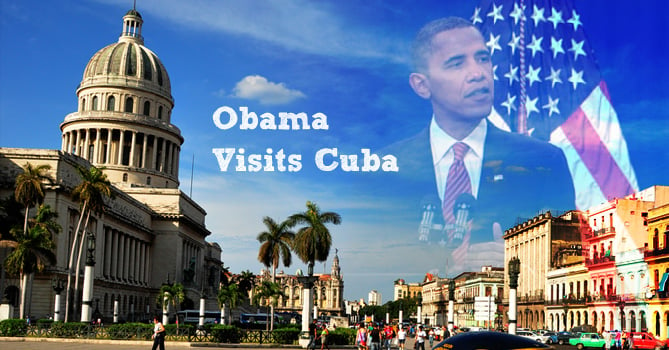In 1928, US President Calvin Coolidge arrived in Cuba on a battleship. That trip was “decorous and dull.” Almost 88 years later, Obama became the next US president to visit the country. One of the first things he said after arriving on Cuban soil was this: “what we did for 50 years did not serve our interests or the interests of the Cuban people.” This change in narrative was possible after the recent thaw in relations starting December 2014. It may be flippant to say that ‘American Arrogance’ of the 1920s has given way to a humbler US with Obama expressing his desire to interact with Cubans in the streets, but there’s certainly a tincture of hope that has risen out of this historic visit.
How do Cubans Interpret this Visit?
People in Havana don’t see anything wrong to welcome the US president in Revolution Square with Che Guevara’s face staring down at him. All they want is change and would like Obama to ‘fix’ great many things that are not right. Cuba has earned the stigma of being a country that disregards dissent and doesn’t listen to the cry for freedom of speech and freedom of expression.
While some want more black Cubans to have a say in the country’s socio-political future, others want freedom from concentration of power in the hands of few individuals.” Cubans want the first black president of the US to show the authorities of this island nation that black people can lead and they ought not be reduced to porters and janitors.
A History of Hostility Between the Two Nations
The visiting US president is as old as the stand-off between Cuba and the US. It all started in 1950s with the armed revolt (Cuban Revolution) by Fidel Castro and his allies against the US-backed authoritarian government. When Castro overthrew the US-backed Cuban dictator Fulgencio Batista in 1959, the bilateral ties began to fray. The US severed diplomatic relations and imposed a trade embargo in 1962 after it failed to invade Cuba in April 1961. It took two years of secret talks initiated by President Obama to restore diplomatic relations. There have been several symbolic progress in the ties since then with the opening of embassies in Washington DC and Havana being one of them.
Candid Discussions
What the two nations should acknowledge and appreciate about each other was the unhindered exchange of criticisms and concerns during the joint press conference by Castro and Obama. While the Cuban President pointed out America’s “shortcomings”, Obama was blatant in his declaration that Cuba needs to improve its record on democracy and human rights, without which both the countries “can’t fully normalize relations.” During the hour-long media conference, Castro was absolutely to the point asking the U.S. to lift the economic embargo on Cuba and “return the territory illegally occupied by Guantanamo Naval Base.”
Sticky Issues
Even though there were “conflicting sentiments within the Communist Party” over hosting the US President and the First Lady, they duo received a warm welcome at the Havana Airport. Obama, who is scheduled to meet the Cuban dissidents today in Havana, has to walk a tightrope. While the members of the Ladies in White – a group that campaigns for release of political prisoners – will make its grievances against the Cuban government known, Obama can’t jump the gun and commit anything that would raise hackles with Raul Castro.
The 54-year-old US trade embargo has been the major concern of the Cubans and Obama had already announced that the embargo would be fully lifted in Cuba. However, the truth is, the US president doesn’t have much in his hands to take things forward. As the situation stands, it is unlikely that the embargo will be lifted any time soon as the US Congress, which is controlled by Republicans, has expressed its opposition to its removal.
Obama’s Gifts to Cuba
Although Obama hasn’t been much of a success when it comes to rescinding the trade ban, he has taken constructive steps towards easing restrictions on travel. He said that direct flights from the US to Cuba would start this year. On the same note, the US cruise company, Carnival, announced on Monday that it will sail the first ship to Cuba in over 50 years. The announcement, which coincided with Obama’s visit, will significantly boost Cuban tourism. Obama also categorically mentioned in one of the press briefing sessions that Google would work with Cuban authorities to expand country’s Wi-Fi and broadband access.
Read More:
- Facts about Bernie Sanders you should know
- US Presidential Election 2016 Facts
- Taiwan elects first female President
- Most powerful people of the world
- Democracies Around the World
- Who will be the next U.S. President?
- South China Sea Dispute
- Can Russia Become a Superpower?
- China’s One-Belt-One-Road (OBOR) initiative
